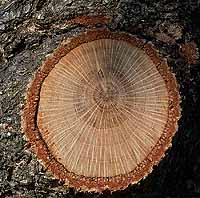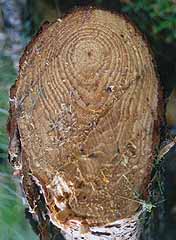Home > Tree structure basics > Strength of different parts > Reaction wood
Reaction wood
A vertical trunk forms normal wood plus some reaction wood when moved in the wind. Horizontal branches and leaning branches must form reaction wood in an attempt to prevent them from bending and cracking under their own weight.
Compression wood forms on the underside of branches and contains more lignin than normal wood. Wood with a high lignin content is especially strong in compression. Tension wood forms on the upper sides of hardwoods and contains more cellulose than normal wood. Wood with a high cellulose content is especially strong in tension and can resist bending downward. Both strategies appear to work most of the time.
Trees in the woods suddenly exposed when most surrounding trees are removed can bend and sometimes break. See: more on this story.
|
|



